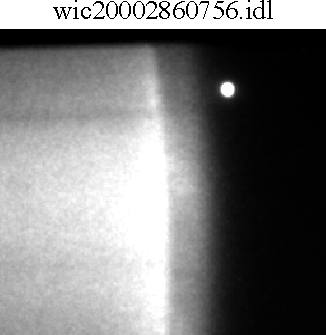
The altitude-brightness profile at the limb measured by WIC is more complicated that one might expect. SI13 shows that the profile of an optically thin (relative to REALLY thick) emission has one peak. WIC shows a primary brightness peak, a very sharp dropoff, and a secondary peak.
Difficulties in analyzing these types of data lie mainly in the fact that the pointing information which accompanies images cannot be taken as 100% correct. Stellar registration of these limb images is difficult since there are very few stars in the equatorial plane, and the current limb-imaging geometry has the equatorial region as a background. But you can get some help as we will see shortly.
Mattieu showed this image obtained on day 286:

Note the brightest limb, the secondary bright region, some auroral striations in both regions, and the star in the airglow. Great image! There is an earlier image with similar features from the previous orbit:

There's our star again, earlier on the same day. But think about this for a second. The right ascension of the orbit plane is fixed. So this is a different star.
But think again. There are NO bright FUV stars in the equator. The center of each of these images is around 0 Declination.
If this were actually the same object... but what moves so quickly?